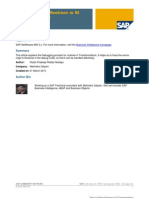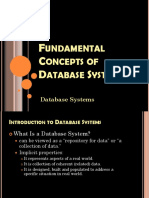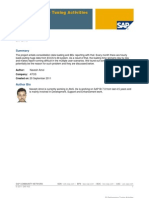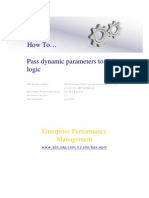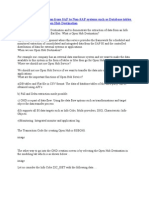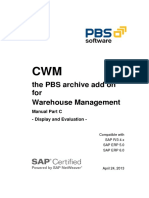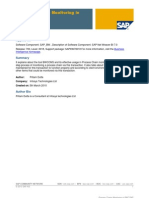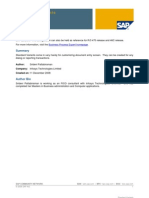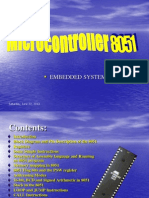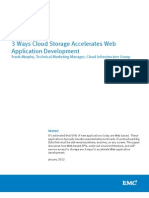How To Delete The Requests From The PSA and Change Log Tables by Using The Process Chain
Uploaded by
Артем БезымянныйHow To Delete The Requests From The PSA and Change Log Tables by Using The Process Chain
Uploaded by
Артем БезымянныйDeleting the Requests from the
PSA and Change Log Tables in
Business Intelligence
Applies to:
SAP BI 7.0. For more information, visit the Business Intelligence homepage
Summary
This paper discusses how to delete the requests from the PSA and Change Log tables by using the Process
Chain and manually in order to increase the desk space and performance of the loading process in BI
System.
Author: Mohammed Abdul Mubeen
Company: Tata Consultancy Services Ltd.
Created on: 17 August 2009
Author Bio
Mohammed Abdul Mubeen is a Certified Business Warehouse Solution Consultant and currently working in
Tata Consultancy Services Ltd . His skills set includes BI, ABAP, MDM and Business Objects
SAP COMMUNITY NETWORK SDN - sdn.sap.com | BPX - bpx.sap.com | BOC - boc.sap.com
© 2009 SAP AG 1
Deleting the Requests from the PSA and Change Log Tables in Business Intelligence
Table of Contents
Introduction: ........................................................................................................................................................ 3
Deleting the Requests from the PSA: ................................................................................................................. 3
Procedure: ....................................................................................................................................................... 3
Including the deletion of requests from the PSA in process chain: .............................................................................. 3
Manually Deleting requests for a Data Source from PSA in RSA1 .................................................................... 7
Result .............................................................................................................................................................. 8
Deleting Requests from the Change Log: .......................................................................................................... 9
Procedure: ....................................................................................................................................................... 9
Including the deletion of requests from the change log into the process chain: ........................................................... 9
Manually Deleting requests from the Change Log tableof the Data Store object in RSA1 : ............................ 13
Conclusion: ....................................................................................................................................................... 14
Related Content ................................................................................................................................................ 15
Disclaimer and Liability Notice .......................................................................................................................... 16
SAP COMMUNITY NETWORK SDN - sdn.sap.com | BPX - bpx.sap.com | BOC - boc.sap.com
© 2009 SAP AG 2
Deleting the Requests from the PSA and Change Log Tables in Business Intelligence
Introduction:
If we do not regularly delete data from the PSA and Change Log tables, the PSA and Change Log tables can
grow to an unlimited size. This increasing the data in the tables will also increase the costs of data retention,
the downtime for maintenance tasks and the performance of the loading process. So we need to delete the
data regularly from the PSA and Change Log tables.
Examples of applications are deleting incorrect requests or deleting delta requests that have been updated
successfully in an Info Provider and that no further deltas should be loaded for.
In SAP-BW 3.5 version, there is only one process type ‘Deleting Requests from the PSA’ is available to do
this activity. This process type can delete the requests from the PSA and Change Log tables in all three BW
Systems.
But in SAP-BI 7.0 version, there are two separate process types ‘Deleting Requests from the PSA’ and
‘Deleting Requests from the Change Log’ are available to do these activities. These process types can
delete the requests from the PSA and Change Log tables in all three BI Systems separately.
Deleting the Requests from the PSA:
This function allows you to delete requests from the PSA/Data Source tables. This reduces the volume of
data in the PSA. We can create the selection patterns in the process variant Deleting Requests from the
PSA and thus delete requests flexibly.
Procedure:
Including the deletion of requests from the PSA in process chain:
We are in the plan view of the process chain where we want to create a process chain for deleting the
requests from PSA and insert this process type in to that process chain.
Go to RSPC in Data Warehouse Work bench and press ‘create’ icon in planning view. In the following
pop-up window we have to enter a technical name and a description of your new process chain.
Now we need to define the start process for this process chain. Each process chain does have one and only
one starting step. Once we enter the technical name and description for the process chain, we will get the
Start Process. .For this process type define the process variant by pressing the Create icon.
SAP COMMUNITY NETWORK SDN - sdn.sap.com | BPX - bpx.sap.com | BOC - boc.sap.com
© 2009 SAP AG 3
Deleting the Requests from the PSA and Change Log Tables in Business Intelligence
Then define the settings for the scheduling of the Start Process of the process chain in the Maintain Start
Process. Let’s say scheduling immediately. Save and come back to the planning view of the process chain. It
looks like below figure
Press enter on the Start Process of the process chain in the planning view. Now we completed the defining
of the Initial Process Type (Start) for the process chain
Now in order to insert the process type for deleting the requests from the PSA in this process chain, go to all
process types ( ) and select the process type Deletion of Requests from the PSA from process category
Other BW Processes by double-clicking.
In the next dialog box, select the Create( ) for entering the technical name and description for the
process variant of Deletion of Requests from the PSA process type.
SAP COMMUNITY NETWORK SDN - sdn.sap.com | BPX - bpx.sap.com | BOC - boc.sap.com
© 2009 SAP AG 4
Deleting the Requests from the PSA and Change Log Tables in Business Intelligence
Once we enter the technical name and description for the process variant of Deletion of Requests from the
PSA process type, select the Continue. Then we get the maintenance screen for the deleting the requests
from PSA in RSPC. Here, we can enter the selection patterns to which requests should be deleted from the
PSA.
In the maintenance screen, enter the Data Source and a Source System names for which all PSA requests
need to delete. We can also use the placeholders Asterisk * and Plus + to select requests with a certain
character string flexibly for multiple Data Sources or Source Systems. For example, if we look in the below
screen, the first data source ZBWDSV* results in the selection of all data sources that start with ZBWDSV
and end with any other characters. The second data source ZBWDSLTA+ results in the selection of all data
sources that start with ZBWDSLTA followed by any other single character.(look below figure)
SAP COMMUNITY NETWORK SDN - sdn.sap.com | BPX - bpx.sap.com | BOC - boc.sap.com
© 2009 SAP AG 5
Deleting the Requests from the PSA and Change Log Tables in Business Intelligence
Note: - We can do the following activities in the above screen,
1) If we set the indicator Exclude Selection Pattern, then this pattern will ignore in the selection.
That means deletion of requests from that PSA will be ignored. For example, if we don’t want to
delete the requests from the data sources which starts with ZBWDSQME, create a second selection
pattern for the data sources ZBWDSQME* and set the indicator Exclude Selection Pattern. Then it
won’t delete the PSA requests from all the data sources starting with ZBWDSQME.
2) We can delete the requests which are Older than N-number of days (or) date in the above screen.
For this one, enter the number of days (or) date in the filed Older than .
3) If we want to select the requests with a certain status then we can also do in the above screen. We
can select the following status indicators in the above screen.
¾ Delete Successfully Updated Requests Only – This status will delete only requests which
are successfully updated into corresponding Info Providers
¾ Delete Incorrect Requests that were not Updated – This status will delete only incorrect
requests which are not successfully updated into the corresponding Info Providers
4) If we want to Copy the settings (age and status) of a particular selection pattern (request selections)
to any other selection pattern then we can do this one by selecting the choose Copy Request
Selections
Now save your entries and return to the previous screen . Then on the next screen, confirm the
Insertion of process type ‘deletion of requests from PSA’ and join the ‘Start’ and ‘Delete PSA
Request’ process types
Once the PSA Deletion process chain is created, activate and schedule it according to your requirements.
SAP COMMUNITY NETWORK SDN - sdn.sap.com | BPX - bpx.sap.com | BOC - boc.sap.com
© 2009 SAP AG 6
Deleting the Requests from the PSA and Change Log Tables in Business Intelligence
Manually Deleting requests for a Data Source from PSA in RSA1
We can also delete the requests from a particular data source manually in the Data Warehousing Workbench
screen.
Select the Data Source for which we want to delete requests from the PSA of a particular data source and
choose Manage by right click on that data source
On the next screen, select one or more requests from the list and choose Delete Request from DB for
deleting the requests from the PSA.
SAP COMMUNITY NETWORK SDN - sdn.sap.com | BPX - bpx.sap.com | BOC - boc.sap.com
© 2009 SAP AG 7
Deleting the Requests from the PSA and Change Log Tables in Business Intelligence
We can also delete requests in Data Source maintenance screen. Choose Go to → Manage PSA
(pushbutton ). Then Delete the requests from the Data Source.
Result
If we delete requests from the PSA, they remain physically in a partitioned PSA table for the time being. The
requests are first deleted logically (from table RSTSODSREQUEST) and are given a deletion flag in PSA
partitioning administration (table RSTSODSPART). But we can no longer access these requests.
The requests are not deleted physically from the PSA table until all requests in a partition have been logically
deleted and have thus been given the deletion flag in PSA partitioning administration
SAP COMMUNITY NETWORK SDN - sdn.sap.com | BPX - bpx.sap.com | BOC - boc.sap.com
© 2009 SAP AG 8
Deleting the Requests from the PSA and Change Log Tables in Business Intelligence
Deleting Requests from the Change Log:
SAP recommends that we need to delete data from the change log table of a Data Store object as well if
several requests that are no longer needed for the delta update and are no longer used for an initialization
from the change log table and have already been loaded into the Data Store object. If a delta initialization is
available for updates to connected Info Providers, requests have to be updated before the corresponding
data can be deleted from the change log.
In some cases the change log table becomes so large, in that case it is advisable to reduce the volume of
data and delete data from a specific time period.
If we have deleted requests form the change log, and the requests can still be seen in the Data Store object
administration screen on the Requests tab, this means that these requests cannot be deleted again on the
Data Store object administration screen This is because the requests have already been deleted from the
change log, which means that it is no longer possible to perform a rollback.
Procedure:
Including the deletion of requests from the change log into the process chain:
We are in the plan view of the process chain where we want to create a process chain for deleting the
requests from Change Log table and insert this process type in to that process chain.
Go to RSPC in Data warehouse work bench and press ‘create’ icon in planning view. In the following pop-Up
window we have to enter a technical name and a description of your new process chain.
Now we need to define the start process for this process chain. Each process chain does have one and only
one starting step. Once we enter the technical name and description for the process chain, we will get the
Start Process. .For this process type define the process variant by pressing the Create icon .
Then define the settings for the scheduling of the Start Process of the process chain in the Maintain Start
Process. Let’s say scheduling immediately. Save and come back to the planning view of the process chain. It
looks like below figure.
SAP COMMUNITY NETWORK SDN - sdn.sap.com | BPX - bpx.sap.com | BOC - boc.sap.com
© 2009 SAP AG 9
Deleting the Requests from the PSA and Change Log Tables in Business Intelligence
Press enter on the Start Process of the process chain in the planning view. Now we completed the defining
of Initial Process Type (Start) for the process chain
Now in order to insert the process type for deleting the requests from the Change Log in the process chain,
go to all process types ( ) and select the process type Deletion of Requests from the Change Log from
process category Other BW Processes by double-clicking.
In the next dialog box, select the Create( ) for entering the technical name and description for the
process variant of Deletion of Requests from the Change Log process type.
Once we enter the technical name and description for the process variant of Deletion of Requests from the
Change Log process type, select the Continue. Then we get the maintenance screen for the deleting the
requests from the Change Log table in RSPC. Here, we can enter the selection patterns to which requests
should be deleted from the Change Log.
In the maintenance screen, select one or more Data Store objects for which requests are to be deleted from
the relevant change log tables under Data Store Object column and select theInfo Area of the corresponding
Data Store Objects under Info Area
SAP COMMUNITY NETWORK SDN - sdn.sap.com | BPX - bpx.sap.com | BOC - boc.sap.com
© 2009 SAP AG 10
Deleting the Requests from the PSA and Change Log Tables in Business Intelligence
Note: - We can do the following activities in the above screen,
1) If we set the indicator Exclude Selection Pattern, then this pattern will ignore in the selection.
That means deletion of requests from that Change Log table will be ignored.
2) We can delete the requests which are Older than N-number of days (or) date in the above screen.
For this one, enter the number of days (or) date in the filed Older than .
3) If we want to select the requests with a certain status then we can also do in the above screen. We
can select the following status indicators from the above screen.
¾ Delete Successfully Updated Requests Only -This status will delete only requests which
are successfully updated into corresponding Data Store objects.
¾ Delete Incorrect Requests that were not Updated - This status will delete only incorrect
requests which are not successfully updated into the corresponding Data Store Objects.
¾ Delete Activation Requests only, No Load requests- This status will delete only the
activation requests (requests that begin with ODSR_... ). No load requests are deleted.
SAP COMMUNITY NETWORK SDN - sdn.sap.com | BPX - bpx.sap.com | BOC - boc.sap.com
© 2009 SAP AG 11
Deleting the Requests from the PSA and Change Log Tables in Business Intelligence
Now save your entries and return to the previous screen. Then on the next screen, confirm the
Insertion of process type ‘deletion of requests from Change Log’ and join the ‘Start’ and ‘Delete Change Log
Request’ process types
Once the Change Log Deletion process chain is created, activate and schedule it according to your
requirements.
SAP COMMUNITY NETWORK SDN - sdn.sap.com | BPX - bpx.sap.com | BOC - boc.sap.com
© 2009 SAP AG 12
Deleting the Requests from the PSA and Change Log Tables in Business Intelligence
Manually Deleting requests from the Change Log tableof the Data Store object in
RSA1 :
In the main menu of Data Store Object administration, choose Environment → Delete Change Log Data.
Now specify the requests which needs to be deleted by determining the number of days Older Than or
Before for a particular date. If we look in the below screen, here I want to delete the requests which are older
than 30 days.
In the above screen, define the start date values under Start Conditions button and press the Start ( )
button for scheduling the deletion of change log requests in the background.
We can also display a request list for the change log table. In that list, we can mark requests and then delete
them directly.
SAP COMMUNITY NETWORK SDN - sdn.sap.com | BPX - bpx.sap.com | BOC - boc.sap.com
© 2009 SAP AG 13
Deleting the Requests from the PSA and Change Log Tables in Business Intelligence
Conclusion:
Finally, so we need to delete the requests from the PSA and Change Log tables regularly by using the
process types ‘Deleting Requests from the PSA’ and ‘Deleting Requests from the Change Log’ in all BI
Systems in order to increase the desk space, costs of data retention, the downtime for maintenance tasks
and the performance of the loading process.
SAP COMMUNITY NETWORK SDN - sdn.sap.com | BPX - bpx.sap.com | BOC - boc.sap.com
© 2009 SAP AG 14
Deleting the Requests from the PSA and Change Log Tables in Business Intelligence
Related Content
For more information, visit the Business Intelligence homepage.
https://www.sdn.sap.com/irj/scn/weblogs?blog=/pub/wlg/5801
https://www.sdn.sap.com/irj/sdn/weblogs?blog=/pub/wlg/3149
https://www.sdn.sap.com/irj/sdn/weblogs?blog=/pub/wlg/2076
For more information, visit the Business Intelligence homepage
SAP COMMUNITY NETWORK SDN - sdn.sap.com | BPX - bpx.sap.com | BOC - boc.sap.com
© 2009 SAP AG 15
Deleting the Requests from the PSA and Change Log Tables in Business Intelligence
Disclaimer and Liability Notice
This document may discuss sample coding or other information that does not include SAP official interfaces and therefore is not
supported by SAP. Changes made based on this information are not supported and can be overwritten during an upgrade.
SAP will not be held liable for any damages caused by using or misusing the information, code or methods suggested in this document,
and anyone using these methods does so at his/her own risk.
SAP offers no guarantees and assumes no responsibility or liability of any type with respect to the content of this technical article or
code sample, including any liability resulting from incompatibility between the content within this document and the materials and
services offered by SAP. You agree that you will not hold, or seek to hold, SAP responsible or liable with respect to the content of this
document.
SAP COMMUNITY NETWORK SDN - sdn.sap.com | BPX - bpx.sap.com | BOC - boc.sap.com
© 2009 SAP AG 16
You might also like
- Step by Step Guide of Report-To-Report Interface in BW ReportingNo ratings yetStep by Step Guide of Report-To-Report Interface in BW Reporting8 pages
- Analysis of Standard Logics - SAP Business Planning and Consolidation For NetWeaverNo ratings yetAnalysis of Standard Logics - SAP Business Planning and Consolidation For NetWeaver12 pages
- Steps To Debug Routines in BI TransformationsNo ratings yetSteps To Debug Routines in BI Transformations12 pages
- Automation of BW Accelerator HousekeepingNo ratings yetAutomation of BW Accelerator Housekeeping23 pages
- Troubleshooting Your ABAP Programs Using Coverage AnalyzerNo ratings yetTroubleshooting Your ABAP Programs Using Coverage Analyzer22 pages
- SAP BW - BI7 Performance Tuning ActivitiesNo ratings yetSAP BW - BI7 Performance Tuning Activities17 pages
- Performance Tuning For Queries With Aggregates: Asap BWANo ratings yetPerformance Tuning For Queries With Aggregates: Asap BWA25 pages
- Integrated Business Planning With SAP Business Planning and ConsolidationNo ratings yetIntegrated Business Planning With SAP Business Planning and Consolidation32 pages
- Checking The Data Using Extractor Checker in ECC Delta and Repea DeltaNo ratings yetChecking The Data Using Extractor Checker in ECC Delta and Repea Delta21 pages
- Sc111-Umoja Procurement Overview CBT v12No ratings yetSc111-Umoja Procurement Overview CBT v1266 pages
- Extraction of Data From SAP To Non-SAP SystemsNo ratings yetExtraction of Data From SAP To Non-SAP Systems5 pages
- The PBS Archive Add On For Warehouse Management: Manual Part C - Display and EvaluationNo ratings yetThe PBS Archive Add On For Warehouse Management: Manual Part C - Display and Evaluation23 pages
- BCF and Account Transformation - Version2No ratings yetBCF and Account Transformation - Version28 pages
- How Can A Reference Query Be Used?: Applies ToNo ratings yetHow Can A Reference Query Be Used?: Applies To14 pages
- How Chamberlain Improved Supplier CollaborationNo ratings yetHow Chamberlain Improved Supplier Collaboration16 pages
- Constrained Forecast Run (Finite Heuristic)No ratings yetConstrained Forecast Run (Finite Heuristic)32 pages
- Step by Step Process For Virtual Key Figures and Characteristics Through BAdiNo ratings yetStep by Step Process For Virtual Key Figures and Characteristics Through BAdi19 pages
- Step by Step Approach To Delete and Recreate Secondary Indices in Process ChainsNo ratings yetStep by Step Approach To Delete and Recreate Secondary Indices in Process Chains9 pages
- Inventory Management (0IC - C03) Part - 2No ratings yetInventory Management (0IC - C03) Part - 210 pages
- Using Query Extract To Export BW Data, With Pros and Cons AnalyzedNo ratings yetUsing Query Extract To Export BW Data, With Pros and Cons Analyzed6 pages
- SAP SRM MDM Catalog 3.0 - (Data Loading) and UI OverviewNo ratings yetSAP SRM MDM Catalog 3.0 - (Data Loading) and UI Overview83 pages
- Cut Over Activities Specific For LIS Data Sources: Applies ToNo ratings yetCut Over Activities Specific For LIS Data Sources: Applies To10 pages
- SAP BW - Dynamic Call Customer Exit Variables Using Same ExitNo ratings yetSAP BW - Dynamic Call Customer Exit Variables Using Same Exit8 pages
- Cs201 Mega Short Questionz Virtual University of Pakistan25% (4)Cs201 Mega Short Questionz Virtual University of Pakistan32 pages
- 3 Ways Cloud Storage Accelerates Webdev 01302012No ratings yet3 Ways Cloud Storage Accelerates Webdev 0130201215 pages
- Loan Risk Analysis With Databricks and XGBoost - A Databricks Guide, Including Code Samples and Notebooks (2019)No ratings yetLoan Risk Analysis With Databricks and XGBoost - A Databricks Guide, Including Code Samples and Notebooks (2019)11 pages
- Power Point Presentation On Topic: C & C++: Submitted By: Himani KathalNo ratings yetPower Point Presentation On Topic: C & C++: Submitted By: Himani Kathal22 pages
- Prafful Bhansali: Year Qualification Institute Cgpa/ %No ratings yetPrafful Bhansali: Year Qualification Institute Cgpa/ %1 page
- Learning JavaScript Data Structures and Algorithms Sample ChapterNo ratings yetLearning JavaScript Data Structures and Algorithms Sample Chapter29 pages
- Ruggedcom Win Free Radius Server Configuration eNo ratings yetRuggedcom Win Free Radius Server Configuration e7 pages
- Unicenter Serviceplus Service Desk: Release SummaryNo ratings yetUnicenter Serviceplus Service Desk: Release Summary16 pages
- Keyboard Shortcuts: User Coordinate System (UCS)No ratings yetKeyboard Shortcuts: User Coordinate System (UCS)1 page
- (Updated 2018) 300-208 Dumps - 300-208 SISAS Exam Questions PDFNo ratings yet(Updated 2018) 300-208 Dumps - 300-208 SISAS Exam Questions PDF11 pages
- HP A5120EI-CMW520-R2220P02 Release Notes (Software Feature Changes)No ratings yetHP A5120EI-CMW520-R2220P02 Release Notes (Software Feature Changes)282 pages
- Introduction To Hacking Postgresql: With Lots of Code Review!No ratings yetIntroduction To Hacking Postgresql: With Lots of Code Review!84 pages
- Step by Step Guide of Report-To-Report Interface in BW ReportingStep by Step Guide of Report-To-Report Interface in BW Reporting
- Analysis of Standard Logics - SAP Business Planning and Consolidation For NetWeaverAnalysis of Standard Logics - SAP Business Planning and Consolidation For NetWeaver
- Troubleshooting Your ABAP Programs Using Coverage AnalyzerTroubleshooting Your ABAP Programs Using Coverage Analyzer
- Performance Tuning For Queries With Aggregates: Asap BWAPerformance Tuning For Queries With Aggregates: Asap BWA
- Integrated Business Planning With SAP Business Planning and ConsolidationIntegrated Business Planning With SAP Business Planning and Consolidation
- Checking The Data Using Extractor Checker in ECC Delta and Repea DeltaChecking The Data Using Extractor Checker in ECC Delta and Repea Delta
- The PBS Archive Add On For Warehouse Management: Manual Part C - Display and EvaluationThe PBS Archive Add On For Warehouse Management: Manual Part C - Display and Evaluation
- Step by Step Process For Virtual Key Figures and Characteristics Through BAdiStep by Step Process For Virtual Key Figures and Characteristics Through BAdi
- Step by Step Approach To Delete and Recreate Secondary Indices in Process ChainsStep by Step Approach To Delete and Recreate Secondary Indices in Process Chains
- Using Query Extract To Export BW Data, With Pros and Cons AnalyzedUsing Query Extract To Export BW Data, With Pros and Cons Analyzed
- SAP SRM MDM Catalog 3.0 - (Data Loading) and UI OverviewSAP SRM MDM Catalog 3.0 - (Data Loading) and UI Overview
- Cut Over Activities Specific For LIS Data Sources: Applies ToCut Over Activities Specific For LIS Data Sources: Applies To
- SAP BW - Dynamic Call Customer Exit Variables Using Same ExitSAP BW - Dynamic Call Customer Exit Variables Using Same Exit
- Cs201 Mega Short Questionz Virtual University of PakistanCs201 Mega Short Questionz Virtual University of Pakistan
- Loan Risk Analysis With Databricks and XGBoost - A Databricks Guide, Including Code Samples and Notebooks (2019)Loan Risk Analysis With Databricks and XGBoost - A Databricks Guide, Including Code Samples and Notebooks (2019)
- Power Point Presentation On Topic: C & C++: Submitted By: Himani KathalPower Point Presentation On Topic: C & C++: Submitted By: Himani Kathal
- Prafful Bhansali: Year Qualification Institute Cgpa/ %Prafful Bhansali: Year Qualification Institute Cgpa/ %
- Learning JavaScript Data Structures and Algorithms Sample ChapterLearning JavaScript Data Structures and Algorithms Sample Chapter
- Unicenter Serviceplus Service Desk: Release SummaryUnicenter Serviceplus Service Desk: Release Summary
- (Updated 2018) 300-208 Dumps - 300-208 SISAS Exam Questions PDF(Updated 2018) 300-208 Dumps - 300-208 SISAS Exam Questions PDF
- HP A5120EI-CMW520-R2220P02 Release Notes (Software Feature Changes)HP A5120EI-CMW520-R2220P02 Release Notes (Software Feature Changes)
- Introduction To Hacking Postgresql: With Lots of Code Review!Introduction To Hacking Postgresql: With Lots of Code Review!







